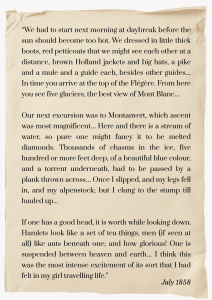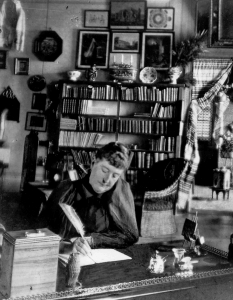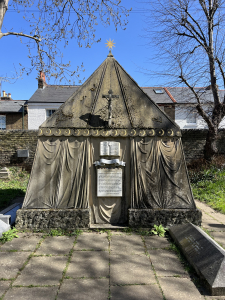Lady Isabel Burton

Isabel Arundell was born on 20th March 1831 and lived for most of her childhood at Furze Hall in Essex. She was a member of the Arundell family of Wardour Castle, a landed Catholic family that had ties to the Elizabethan court.
Isabel had a strict but happy childhood, spending her time reading and exploring the local Essex countryside. She was educated at a convent school and later went to London and France to continue her education and enter into society.
Her interest in the middle east and nomadic communities is something Isabel traces back to her childhood. The idea of a “wild and lawless life” was exciting and mystical.
As a teenager she befriended a travelling Romany community that passed through near her home despite being strictly forbidden to do so. Her particular friend Hagar Burton whom she described as “a tall, slender, handsome, distinguished, refined woman, who had much influence in her tribe”, read her horoscope and offered a prophecy for her life:
“You will cross the sea and be in the same town as your destiny and know it not. Every obstacle will rise up against you, and such a combination of circumstances, that will require all your courage, energy, and intelligence to meet them… your life is all wandering, change, and adventure. One soul in two bodies in life or death, never long apart.”
– Hagar Burton
Isabel and Richard Burton
The couple first met in Boulogne while walking on the ramparts. Isabel saw Richard from afar, not knowing who he was, and described his appearance in great detail:
“He was 5’11” in height, very broad, thin and muscular: he had very dark hair; black, clearly defined sagacious eyebrows; a brown, weather-beaten complexion; straight Arab features; a determined looking mouth and chin, nearly covered by an enormous black moustache… but the most remarkable part of his appearance was two large, black, flashing eyes with long lashes that pierced one through and through. He had a fierce, proud, melancholy expression; and when he smiled, he smiled as though it hurt him, and looked with an impatient contempt at things generally.”
Isabel turned to her sister to say: “That man will marry me.”
The couple would wait ten years before marrying disregarding the reservations from their families. During this time, Richard embarked on some of his most famous journeys and Isabel followed news of him through the papers and the books he published.
W H Wilkins explained that Isabel was a key part of the successes of Richard’s career in the consular service. Her influence in society as well as her family and connections are considered a major reason why Richard obtained the position of consul at Damascus, fulfilling the couple’s dream of a life in Syria.


Isabel, the Explorer
Isabel’s interest in the world, its people and cultures, was evident long before she married Richard Burton.
As a young woman, she was an experienced international traveller, visiting multiple European countries. In 1857-58 she joined her sister, Blanche, and her new husband on a tour to Italy and Switzerland.
During this trip, Isabel experienced the highs and lows of 19th-century travel. She described the beauty of the scenery she saw, the cultures and traditions of the local people, and improved her languages skills. She wrote about travelling for days on end with little sleep and being uncomfortable in her clothes.
Throughout her marriage to Richard, Isabel was able to fulfil her ambitions for travel and adventure. She travelled to Madeira and Tenerife, Brazil, India, Syria, Egypt, Palestine, and across Europe.
“Richard was my guide to all things; and since he adapted himself to the native life, I endeavoured to adapt myself to it also, not only because it was my duty, but because I loved it… we wore native dress in the desert. I always wore the men’s dress on our expeditions in the desert and up the country. By that I mean the dress of the Arab men. This was not so dreadful as Mrs Grundy may suppose, as it was all drapery, and does not show the figure. There was nothing but the face to show the curious whether you were a man or a woman.”
Isabel, the Writer
“Blessed be they who invented pens, ink, and paper!”
As a child, Isabel enjoyed reading and writing. Her memoirs, a collection of her own writing and some reflections by W H Wilkins tell an engaging narrative of her life and travels. The Romance of Isabel, Lady Burton, published after her death in 1897 include elements of traditional travel writing and anthropological observations of the people she encountered. Some of her descriptions of the people she saw were highly positive, others were rather insulting.
During her lifetime, Isabel published a number of successful books, most notable were: The inner life of Syria, Palestine, and the Holy Land (1875), Arabia, Egypt, India: a narrative of travel (1879), and, The life of Captain Sir Richard Francis Burton (1893). She was also involved in the editing and publishing of some of Richard’s work.
When Richard died in 1890, Isabel was given the rights to manage Richard’s written estate. She decided to destroy many of his papers including a translation of The Perfumed Garden (due to be retitled The Scented Garden). However, according to Mary S Lovell, this act was not so complete as she is often accused. Many papers relating to the Burtons remain in archives today.



Isabel and the Burton Mausoleum
When Richard Burton died in Trieste in 1890, Isabel commissioned Messrs Dyke and Son of Highgate Road to build the Burton Mausoleum in Mortlake.
The design, agreed between Isabel and Richard before his death, is based on the Bedouin-style tents they used when travelling through the desert in Syria. This was a happy time for the couple, and Richard had stated that he would like them to lay side by side, above ground, in a tent.
Isabel organised the repatriation of Richard’s body to London and the funeral was held at St Mary Magdalen Roman Catholic Church on 15th June 1891.
The mausoleum is filled with objects from their lives together, much of which was taken from their home in Trieste. The camel bells hung in the ceiling were purchased specifically for the mausoleum and would ring when the door was opened.
You can learn more about the History of the Burton Mausoleum and Messrs Dyke and Son on our website.
Isabel lived the rest of her life between her properties in Baker Street and a cottage in Mortlake. She visited the mausoleum often, sitting inside to pray and read.
Isabel died on 22nd March 1896 and her coffin was placed in the mausoleum alongside Richard. The Book of Life on the mausoleum door was updated to read “Isabel, His Wife” as per her instructions.